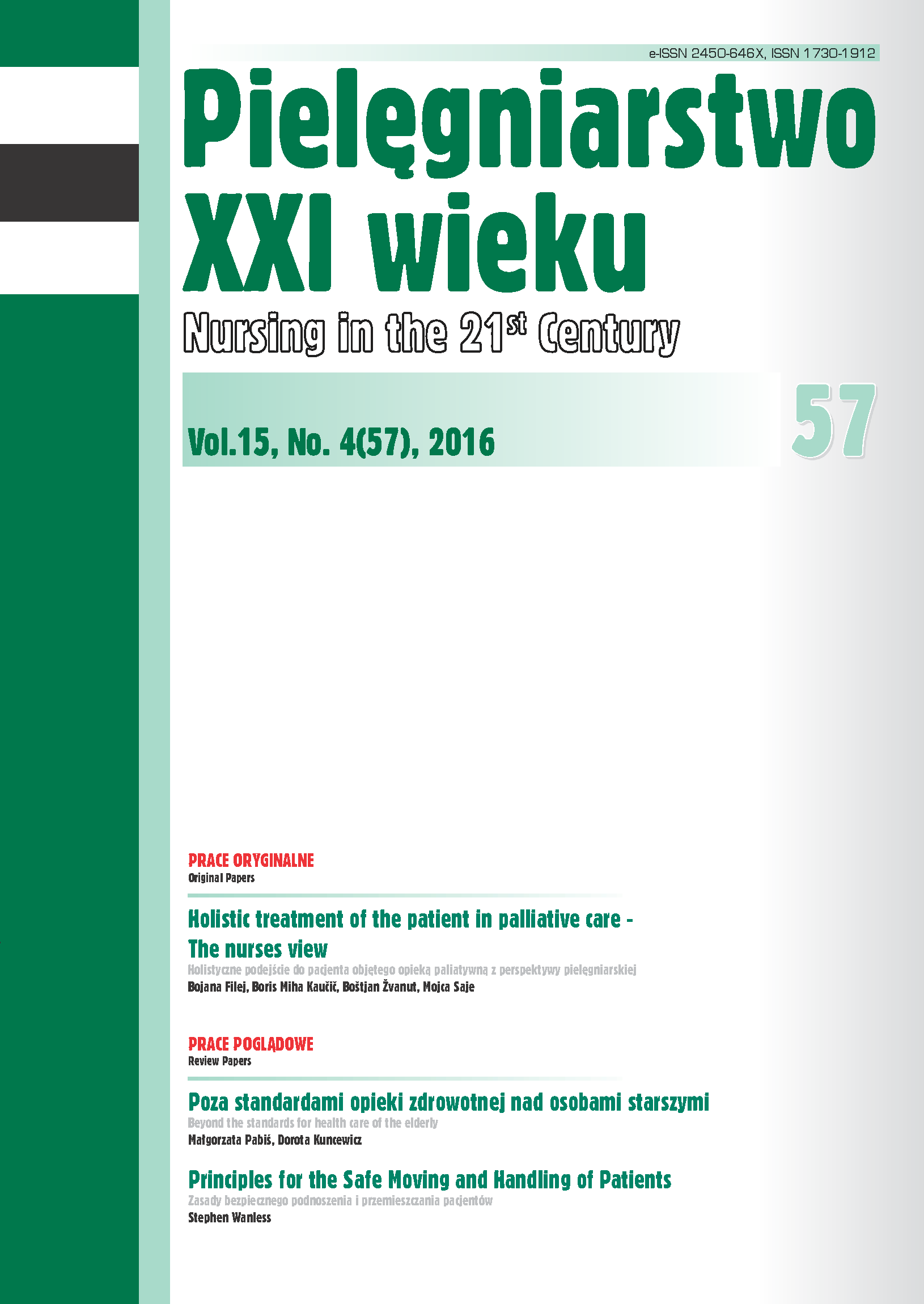Polish adaptation of the Iowa Satisfaction with Anaesthesia Scale
DOI:
https://doi.org/10.1515/pielxxiw-2016-0034Keywords:
validation studies, anaesthesia, maxillofacial surgery, nursing careAbstract
POLISH ADAPTATION OF THE IOWA SATISFACTION WITH ANAESTHESIA SCALE
Introduction. The paper presents the adaptation of the Iowa Satisfaction with Anesthesia Scale to the conditions in Polish hospitals.
Methods. The proces of cultural adaptation of the Iowa Satisfaction with Anesthesia Scale was divided into three stages. The first stage was to formulate the Polish version of the ISAS. Secondly, the scale was used in the group of patients who were diagnosed with a maxillofacial injury and underwent surgical procedure. The final stage evaluated the psychometric features of the Polish version of the ISAS.
Results. 195 questionnaires were completed correctly and they were subject to further analysis. The questionnaires were collected from patients residing at the Maxillofacial Surgery Clinical Ward who were operated under a general anaesthesia due to a maxillofacial trauma. The average result of the satisfaction with anaesthesia in a studied group was 0.77 (scale from -3 to +3) M=2, SD=2.41. The Cronbach’s alpha coefficient calculated for 11 multiple choice questions was 0.598. It would be possible to increase the Cronbach’s aplha coefficient if question no. 1 (I vomited or felt nauseous) was eliminated from the test (maximum 0.601). Every item on the scale had significant influence on the general result (p=0.0001).
Conclusions. Polish version of the Iowa Satisfaction with Anesthesia Scale meets the criteria of the psychometric equivalence with the original version. It is necessary to continue research using Polish version of the ISAS to provide a constatnt verification of reliability and accuracy of the research tool.
References
1. Wanyura H. Urazy szkieletu czaszkotwarzowego. Kryst L. (red.). Chirurgia Szczękowo-twarzowa. Warszawa: PZWL; 2007.
2. Wołowicka L, Dyk D. Anestezjologia i intensywna terapia. Klinika i pielęgniarstwo. Warszawa: PZWL, 2008.
3. Paleczny J, Łoniewska-Paleczny E, Pysz M, Hura G. Porównanie zastosowania piersiowej blokady przykręgowej i znieczulenia ogólnego w chirurgii gruczołu piersiowego. Anestezjologia Intensywna Terapia. 2005; 37: 12-16.
4. Dexter F, Aker J, Wright W. Development of a Measure of Patient Satisfaction with Monitored Anesthesia Satisfaction with Anesthesia Scale. Anesthesia Analgesia. 1997; 87(4): 865-873.
5. Fung D, Marsha M. What Determines Patient Satisfaction with Cataract Care Under Topical Local Anesthesia and Monitored sedation In a Community Hospital Setting. Anesthesia Analgesia. 2005; 100: 1644-1650.
6. Cohen M, Duncan P, Pope W, et al. The Canadian four-centre study of anesthetic outcomes. II. Can outcomes be used to assess the quality of anesthesia care? Canadian Journal of Anesthesia. 1992; 5: 430-439.
7. Eagle CJ, Davies JM. Current models of „quality”: an introduction for anesthetists. Canadian Journal of Anesthesia. 1993; 9: 851-862.
8. Pagenkopf D, Davies JM, Bahan M, et al. A complementary approach to outcome analysis in the parturient. International Journal of Health Care Quality Assurance. 1991;4:241-245.
9. Duncan P. Quality: a job well done!. Canadian Journal of Anesthesia. 1993; 9: 813- 815.
10. Orkin F, Cohen M, Duncan P. The quest for meaningful outcomes. Anesthesiology. 1993; 3: 417-422.
11. Meakin R, Weinman J. The Medical interview Satisfaction scale` (MISS-21) adapter for British general Practice. Family Practice. 2002; 19: 257-263.
12. Fleisher L.A, Mark L. Disseminating information using an anesthesiology Consultant report: impast on patient perceptions of quality of care. Journal of Clinical Anesthesia. 1999; 11(5): 380-385.
13. Pascal A. Development and Validation of a Perioperative Satisfaction Questionnaire. Anesthesiology. 2005; 102: 1116-1123.
14. Capuzzo M, Landi F, Bassani A, et al. Emotional and interpersonal factors are most important for patient satisfaction with anaesthesia. Acta Anaesthesiologica Scandinavica. 2005; 49: 735-742.
15. Schiff JH, Fornaschon AS. The Heidelberg Peri-anaesthetic Questionnaire-development of a New refined psychometric questionnaire. Anesthesia. 2008; 63: 1096-1104.
16. Dexter F, Candiotti K. Multicenter Assessment of the Iowa Satisfaction with Anesthesia Scale, an Instrument that Measures Patient Satisfaction with Monitored Anesthesia Care. Anesthesia Analgesia. 2011; 113(2): 364-368.
17. Wild D, Grave A, Marti M, et al. Principles of good practice for the translation and cultural adaptation process for patient-reported outcomes (PRO) measures: Report of the ISPOR Task Force for Translation and Cultural Adaptation. Value in Health. 2005; 8: 94–104.
18. Benatar-Haserfaty J, Monleon de la Calle, Sanz- Lopez A, Muriel Garcia A. Outpatient external dacryocystorhinostomy under regional anesthesia and sedation. Revista Española de Anestesiología y Reanimación. 2007; 54(1): 23-28.
19. Fung D, Cohen M, Stewart S, Davies A. Can the Iowa Satisfaction with Anesthesia Scale be used to measure patient satisfaction with cataract care under topical local anesthesia and monitored at a community hospital? Anesthesia Analgesia. 2005; 100(6): 1637-1643.
20. Jiménez GarcíaF, Del Real Capera A. Validation to Spanish of the Iowa Satisfaction with Anesthesia Scale (ISAS) for monitored anesthesia care in ophthalmic surgery. Rev Col Anesth. 2014; 42: 272-280.
Published
Issue
Section
License
Copyright (c) 2016 Authors

This work is licensed under a Creative Commons Attribution-NonCommercial-NoDerivatives 3.0 Unported License.




